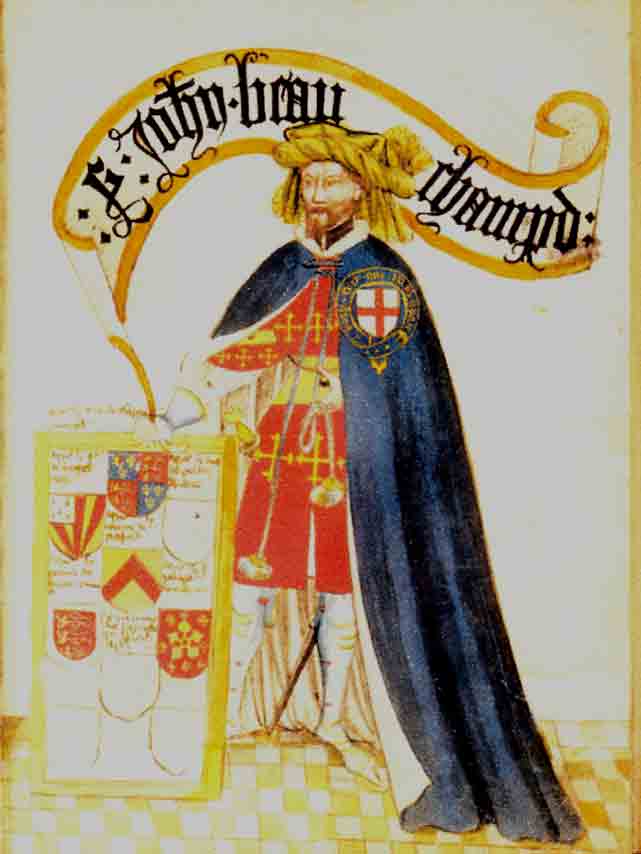
Sir John de Beauchamp, 1st. Lord Beauchamp of Warwick, was a younger son of Guy de Beauchamp, 10th Earl of Warwick and a brother of Thomas, 11th Earl of Warwick. The brothers were founder members of the Order of the Garter in 1348, Sir John’s his stall was number 11. Maud, a sister, was married to Geoffrey de Say, 2nd Baron Say, the overlord of Essewelle.
At some time after 1346 Sir John de Beauchamp (also Bello Campo), acquired several holding in and around the parish of Nonington, the post mortem inquisition after his death in 1360 recorded these as:
Monketon, (now Gooseberry Hall Farm) consisting of eight acres of arable; land, unspecified land at Adesham (Adisham) which may in fact refer to Monketon which was part of the manor of Adisham; 24s rent of free tenants at Fredevill; tenements at Easole consisting of a messuage with dovecot, 60 acres of arable land and 12 acres of pasture all held of the Abbot of St. Alban’s, (this is believed to be what later became known as Beauchamps or Bechams and the messuage with dovecot is one of a series of manorial buildings on the site which are currently being excavated); Wyngeham (Wingham), no details specified but probably refers to property in Nonington held from the manor of Wyngeham, most likely in North or South Nonington; Godneston (Goodnestone), 5s land-unspecified.
The same inquisition also recorded Sir John’s other Kent holdings. These were the adjoining manors of Silham and Mere in the southern part of Rainham parish in Kent which lay some 34 miles south of London on the London to Dover road, and Cheddyngston, now Chiddingstone, manor in Cobham parish which lay on the same road some seven miles closer to London. Travelling via Canterbury Nonington was some thirty five or so miles further from these manors, thirty-five was probably the maximum distance easily travelled daily on the roads of the time.
Sir John lived primarily in London where he built a large house later bought by the Crown and used for the King’s Wardrobe and the Rainham manors were most likely acquired with the intention of accommodating Sir John’s family and entourage on journeys between London and his Nonington holdings, which in turn were convenient for Sandwich, then the main port for travelling to northern France and the Low Countries where Sir John and the Earl of Warwick were frequently involved in fighting the French and their allies.
Sir John was one of the foremost soldiers in England. He was with King Edward III in Flanders in 1338; at the array at Vironfosse in October, 1339, when the armies of the English and French kings met but did not come to battle; and took part in the sea battle of Sluys on 24th June, 1340.
In the great English victory at the Battle of Crécy on 26th August, 1346, Sir John carried the Royal Standard whilst fighting alongside the Earl of Warwick and their brother-in-law, Lord Say. He was also present at the siege of Calais lasting from September, 1346 to August, 1347, which gained possession of Calais for the English Crown where it remained until 1558 when it was lost for good by Mary Tudor, who then reputedly said “”When I am dead and opened, you shall find ‘Calais’ lying in my heart”.
In 1347 Edward III made Sir John was made a Knight Banneret with an annual allowance of £140 to enable him to support this title, and the following year he was made Captain of Calais. Soon after this the King appointed him Admiral of the Fleet; Constable of the Tower of London; and Warden of the Cinque Ports and in 1350 Sir John was summoned to Parliament among the Barons where served until his death. Sir John lost the position of Constable of the Tower in 1354 because of rumours against him, but the King subsequently reappointed him when these proved unfounded.
Fulfilling his duty as Captain of Calais Sir John Beauchamp, 1st. Lord Beauchamp of Warwick, died there from plague on 2nd December, 1360, and was buried between two pillars before the image of the Virgin on the south side of the nave of Old St. Paul’s Cathedral where there was a monument to his memory, commonly, and incorrectly, called “Duke Humphrey’s Tomb” John, had no legitimate children so his title became extinct.
On his death Easole, which Sir John had held in Gavelkind [a freehold tenure], was enfeoffed to Sir John’s nephews and in 1368 they offered “le manoir de Easole” to Christ Church in Canterbury on the condition: “namely, that one of your monks there should be perpetually specially assigned and deputed to sing mass, at the Altar of Our Lady in the Crypt, wearing vestments decorated with the arms of the Warwick family, and praying for the souls of our said uncle and our ancestors”. ChristChurch responded that: “to bear and perform such a charge for so small a repayment, where there is scarcely any profit, would be too burdensome for us; wherefore, Sire, be pleased in this case to have us excused”. This is an indication of how unprofitable agricultural land had become in the aftermath of the Black Death, sporadic outbreaks of which still occurred in England well into the 1360’s and beyond.

